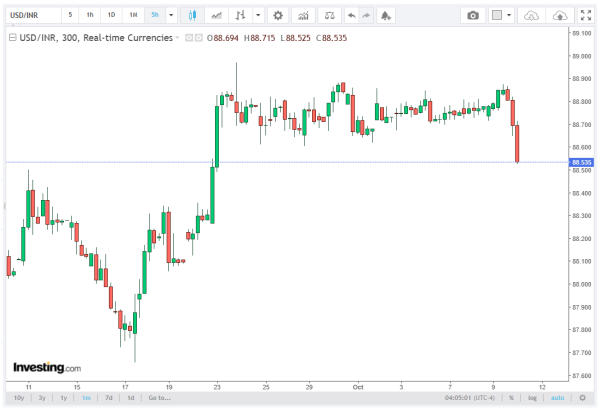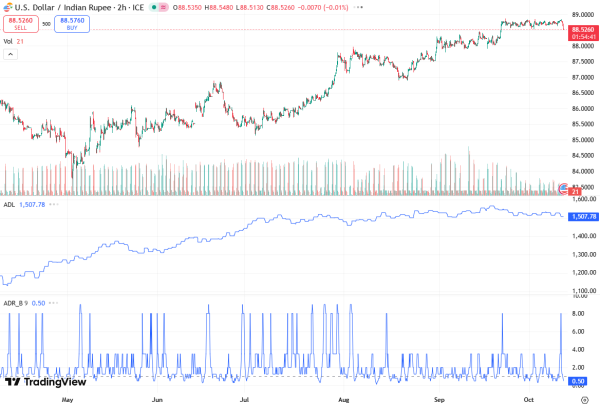The Indian Rupee (INR) showed notable gains against the US Dollar (USD) during India’s afternoon trading session on Friday. The USD/INR pair retraced sharply to near 88.74, marking a correction from its over two-week-long range of 88.75-89.10.
Despite the US Dollar trading firmly, the INR demonstrated resilience, highlighting the currency’s strength amid global and domestic market factors. The Solancie team provides a thoughtful and comprehensive breakdown of the subject.
The Reserve Bank of India (RBI) has been actively supporting the Rupee to prevent further depreciation against the Greenback, reinforcing stability in the foreign exchange (FX) market.
Foreign Investment Sentiment Supports the Rupee
A slight improvement in the sentiment of Foreign Institutional Investors (FIIs) towards the Indian equity market has emerged as a key driver of the Rupee’s strength. During October 7-9, FIIs turned net buyers, acquiring Rs. 2,830.10 crores worth of shares.
Although this buying is modest compared to the massive selling in the past months, it marks a potential turning point in capital flows, providing support to the INR.
In the July-September quarter, FIIs sold equities worth Rs. 1,29,870.96 crores in the Indian secondary market, creating downward pressure on the Rupee. A shift in foreign fund flows back into Indian equities could potentially strengthen the currency further.
Geopolitical and Global Dollar Pressures
The Indian Rupee has faced sustained weakness due to geopolitical tensions and trade dynamics. The United States raised tariffs on India to 50%, penalizing New Delhi for importing Russian oil, which Washington argues supports Moscow in the Ukraine conflict.
High demand for the USD from Indian importers, especially for oil and jewelry purchases, has been a major drag on the INR. Additionally, consistent FII outflows have compounded the pressure on the currency.
Meanwhile, the US Dollar Index (DXY) remains strong, trading near a two-month high of 99.50, fueled by safe-haven demand amid political instability in France and reduced hawkish expectations in Japan after Sanae Takaichi was elected Prime Minister.
Domestically, concerns over a potential US government shutdown, following the Senate’s failure to pass a short-term funding bill, have added volatility to global markets, indirectly affecting the USD/INR pair.

Fed Commentary: A Factor for Dollar Weakness
Dovish signals from Federal Reserve (Fed) officials could weigh on the USD and indirectly support the INR.
New York Fed President John Williams indicated the need for more interest rate cuts this year due to slowing jobs growth and reduced corporate hiring. Williams emphasized the importance of returning interest rates to neutral levels.
San Francisco Fed President Mary Daly echoed the call for additional rate cuts, citing a softening labor market and slower economic growth.
Conversely, Fed Governor Michael Barr urged caution, warning that inflation may not return to the 2% target before 2027, which could influence the USD trend in the coming months.
The expectation of rate cuts may decrease dollar demand, creating favorable conditions for the INR.
Technical Analysis: USD/INR Movement
From a technical perspective, the USD/INR pair breached its two-week trading range on the downside, moving closer to the 20-day Exponential Moving Average (EMA) around 88.70. The 20-day EMA currently slopes higher, suggesting the medium-term trend remains cautiously bullish, but short-term momentum favors the Rupee.

The 14-day Relative Strength Index (RSI) has fallen below 60.00, signaling that the strong bullish momentum in USD/INR has temporarily ended.
Support levels to watch include the September 23 low of 88.57, while resistance is expected near the all-time high of 89.12. A break above 90.00 could reignite the uptrend, although current market conditions favor downside correction.
Outlook for Indian Rupee
The combination of increased foreign investment, RBI intervention, and potential Fed rate cuts may lend further support to the INR. If FIIs continue buying Indian equities, the USD/INR pair could face additional downside pressure, potentially moving towards 88.50 in the near term.
Conversely, sustained demand for USD in import-heavy sectors, geopolitical risks, and global dollar strength could limit further Rupee appreciation, keeping the pair range-bound around 88.70-89.10.
Investors and traders should monitor foreign fund flows, RBI policy moves, and Fed commentary, as these remain key catalysts for USD/INR movements.
Conclusion:
The Indian Rupee has gained momentum against the US Dollar, with the USD/INR pair correcting near 88.74, supported by a return of foreign funds into Indian equities.
Technical indicators suggest a potential continuation of the downside, while macro factors such as Fed policy outlook and geopolitical developments will play a critical role in shaping future currency trends.










